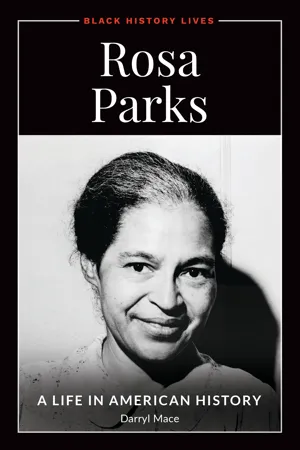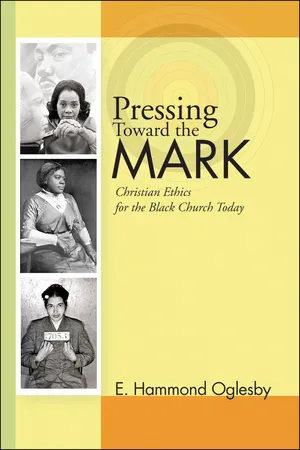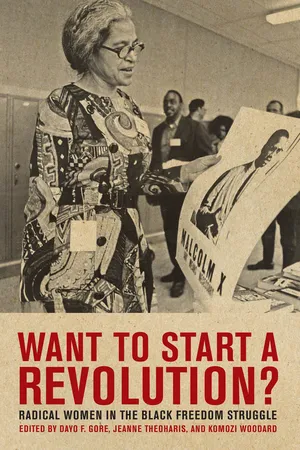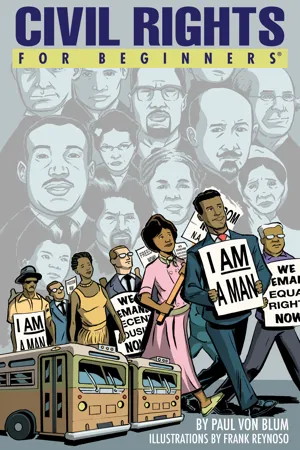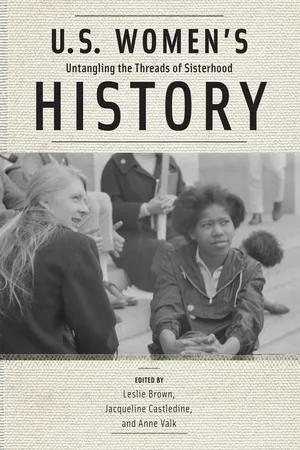History
Rosa Parks
Rosa Parks was an African American civil rights activist known for her pivotal role in the Montgomery Bus Boycott. On December 1, 1955, she refused to give up her seat to a white passenger on a segregated bus, sparking a major turning point in the civil rights movement. Her act of defiance and the subsequent boycott led to significant advancements in the fight against racial segregation.
Written by Perlego with AI-assistance
Related key terms
9 Key excerpts on "Rosa Parks"
- eBook - ePub
- Eric Metaxas(Author)
- 2015(Publication Date)
- Thomas Nelson(Publisher)
SIX Rosa Parks 1913–2005I f you have heard of Rosa Parks, you know that this famous woman entered the history books for refusing to give up her seat on a bus. This simple act launched the now-historic yearlong Montgomery bus boycott, which in turn catapulted Martin Luther King Jr. to fame and effectively set in motion the Civil Rights movement. For this reason, Rosa Parks is rightly remembered as the “Mother of the Civil Rights Movement.”But just how did this humble, dignified woman come to be the focal point of this period in American history? And what became of her after that fateful day on that bus? This is her story.R osa McCauley was born in Tuskegee, Alabama, on February 4, 1913, to Leona Edwards McCauley, a schoolteacher, and James McCauley, a carpenter and stonemason.For Rosa and for most blacks at that time, faith and the church were at the center of life. The church was a welcome, life-filled refuge from the bitterness of that time and place, one known for the lynching and burning of innocent blacks for their alleged crimes against white people. From her earliest years, Rosa loved the words and music of the church. Throughout her life, she attended the African Methodist Episcopal Church.“Daily devotions played an important part in my childhood,” she said. “Every day before supper, and before we went to services on Sundays, my grandmother would read the Bible to me, and my grandfather would pray. . . . I remember finding such comfort and peace while reading the Bible. Its teachings became a way of life and helped me in dealing with my day-to-day problems.”1But the Bible had a social mandate in its message too, one that taught Rosa that “people should stand up for rights, just as the children of Israel stood up to the Pharaoh.”2 - eBook - ePub
The Possibility of Contemporary Prophetic Acts
From Jeremiah to Rosa Parks and Martin Luther King, Jr.
- Bush(Author)
- 2013(Publication Date)
- Pickwick Publications(Publisher)
The historical and anecdotal evidence associated with Rosa Parks’s act suggests that it can be evaluated positively in regards to all four of these categories. The act of refusing to move from her bus seat definitely caught the attention of the bus driver and all the other passengers, both in terms of the nature and quality of Parks’s civil disobedience. For example, when James Blake threatened Parks with being arrested, her measured response was “You may do that.” This identified her not as a passive victim but as an active protester of the bus segregation laws. That the severity of the act was readily apparent and easily comprehended is seen in how Blake immediately called for two policemen to come and arrest Parks. According to testimony gathered later, the witnesses to Parks’s self-possessed act sat in stunned, silent recognition that this time the authorities had picked the wrong woman to mess with. 138 These same witnesses were able to provide accurate descriptions of what transpired that day, enabling a broad retention of the details and facts associated with this event. Lastly, the widespread reaction to Parks’s arrest, especially among those who personally knew her, was one of anger, frustration, and a renewed commitment to work for change, so that such painful incidents would not happen again in their community. Is it possible to speak about what Tillich calls a kairos moment occurring on that December day? In remembering Parks’s historic act, one recurrent question is whether or not it was planned or premeditated. Douglas Brinkley, Parks’s biographer, answers with a clear “No.” As he puts it, a “lifetime’s education in injustice—from her grandfather’s nightly vigils to the murder of Emmett Till—had strengthened her resolve to act when the time came.” 139 Martin Luther King, Jr - eBook - ePub
Rosa Parks
A Life in American History
- Darryl Mace(Author)
- 2021(Publication Date)
- ABC-CLIO(Publisher)
Why does Rosa Parks matter? She matters because her life is a moving example of the life of black Americans. Born in a town that held the promise of racial uplift, Parks’s life showed the harsh reality of African American lives. She learned how to stand up for herself, how to stay alive, and the importance of education in the process of black uplift during her formative years; and she carried those lessons into adulthood. Rosa Parks, like many other black people focused on racial justice, surrounded herself with positive activists who wanted to bring about social change. She worked tirelessly, despite limitations placed on her by her gender and the gender roles of U.S. society, to see racial justice. Rosa Parks directed her efforts in support of black institutions and organizations bent on racial uplift, and she did what she could within the confines of gender norms to push for equality. Understanding the crucial nature of education, Rosa Parks worked with youth in Montgomery, and she educated herself in many ways, including her voracious reading habits and her time at Highlander Folk School. When it came time for Rosa Parks to take a stand in protection of her civil and corporal rights, she did so without hesitation. From her first refusal to give up her seat on the segregated buses in 1943 through her arrest in 1955 for violating segregation laws, Rosa Parks was in control of her person, because she knew that in white supremacist America, her civil rights depended on her corporal rights. After her arrest, Parks worked within the spaces afforded women to raise money and support for the Montgomery Bus Boycott, and she continued to support mass organizing efforts on the part of organizations like the MIA and the NAACP. Rosa Parks joined other black protestors in moving away from oppressive conditions in the South. While conditions in the North often mirrored those in the South, Rosa knew that removing herself from Montgomery was a way of taking control of her body and forwarding her black protest initiatives. In Detroit, she continued to work with activists on black protest efforts, in that city and around the country. Connecting with the plight of blacks in South Africa, Rosa lent her efforts to battling apartheid in that African nation.Rosa Parks matters because hers is a story of civil rights and black protest regionally, nationally, and internationally. She matters because studying her life illuminates the cultures of gender, white supremacy, and black protest that are at the heart of the American narrative. Her story matters precisely because it is not a fable of the American dream. Rather than a fanciful American dream narrative, like the rest of black Americans, Rosa Louise Parks’s story is the story of the reality of black life in America. - eBook - ePub
The Civil Rights Movement
A Documentary Reader
- John A. Kirk, John A. Kirk(Authors)
- 2020(Publication Date)
- Wiley-Blackwell(Publisher)
Chapter 3 The Montgomery Bus Boycott and the Southern Christian Leadership Conference, 1955–73.1 Rosa Parks Recalls Her Role in the Montgomery Bus Boycott in 1955
Rosa Parks’s arrest aboard a Montgomery bus on 1 December 1955 has become an iconic moment in the civil rights movement. Interpretations of what that event means have changed significantly over time. Early representations of Parks’s actions, notably in Martin Luther King, Jr’s account of the bus boycott, Stride Toward Freedom (Harper & Row, 1958), portrayed Parks as a tired seamstress who spontaneously decided to defy segregation laws because her feet hurt. This was part of a conscious attempt at the time to depoliticize Parks’s actions and to instead emphasize the human element of the bus boycott, not least to avoid the common charge of communist‐inspired agitation against activists that was prevalent in the wake of Sen. Joseph McCarthy’s anticommunist crusades that had gripped the nation.More recently historians have become aware of Parks’s longstanding commitment to racial and social justice struggles. Before making her protest, Parks had been the secretary in the local Montgomery National Association for the Advancement of Colored People (NAACP) branch, she had attended classes in social justice at Highlander Folk School in Tennessee, and she had been involved in women’s issues, including investigations into the rape of black women by white men. Parks was well connected to activist networks in the local black and white communities. While her actions on 1 December do not appear to have been part of any formally preconceived plan to trigger a bus boycott, Parks made a politically conscious and informed choice in the context of decades of personal activism to defy segregation law on a Montgomery bus.When I got off from work that evening of December 1, I went to Court Square as usual to catch the Cleveland Avenue bus home. I didn’t look to see who was driving when I got on, and by the time I recognized him, I had already paid my fare. It was the same driver who had put me off the bus back in 1943, twelve years earlier. He was still tall and heavy, with red, rough‐looking skin. And he was still mean‐looking. I didn’t know if he had been on that route before – they switched the drivers around sometimes. I do know that most of the time if I saw him on a bus, I wouldn’t get on it. - eBook - ePub
Pressing Toward the Mark
Christian Ethics for the Black Church Today
- Oglesby(Author)
- 2007(Publication Date)
- Wipf and Stock(Publisher)
No one chooses to be a centering moment for history’s favor or disfavor. No one chooses to be a “rose” because realists of the womanist persuasion, all too well, know that “thorns” come along with the roses. No one chooses to intentionally fall on her or his sword, as an act of valor—while the steep walls of racial segregation must be climbed. So then, the humiliating incident suffered by Mrs. Rosa Parks was unplanned, unrehearsed. There was no tactical “wizard of Oz” that conjured up a suitable person with a suitable scheme to contest the traditional bus segregation laws in the Deep South. Somehow, I cannot help but believe that God was in the plan, from the beginning, guiding the courageous action and finite rhythms of Rosa Parks, on that unforgettable Thursday evening (December 1, 1955), around 5:30 p.m. as she boarded the Cleveland Avenue bus in downtown Montgomery. There is, I think, an African American proverb that reads: “Where God guides, God always provides!” Accordingly, Rosa Parks was “guided” to resist the injustice of segregation in American society and to rebel against those who would be prone to mistreat her based on skin-color. Here, I am reminded of the profound wisdom often articulated by Dr. Benjamin E. Mays, former President of Morehouse College (Atlanta, Georgia), to his students on campus: Fleecy locks and dark complexion cannot forfeit nature’s claim; skin may differ, but intellect and affection run in black and white the same. 13 Symbolically and contextually Rosa Parks’s immediate Civil Right’s posse after this historic incident supported her in an understanding of faith as seeing the glass half full —despite the difficulty in the collective struggle for a new social order reflective of freedom, racial equality, and the concrete dismantling of the laws of segregation. Faith is never easy when it has to be tested - eBook - ePub
Want to Start a Revolution?
Radical Women in the Black Freedom Struggle
- Jeanne Theoharis, Komozi Woodard, Dayo F. Gore(Authors)
- 2009(Publication Date)
- NYU Press(Publisher)
5 “A Life History of Being Rebellious” The Radicalism of Rosa Parks Jeanne Theoharis In all these years. . . it’s strange. . . but maybe not. . . nobody asks. . . about my life. . . if I have children. . . why I moved to Detroit. . . what I think. . . about what we tried. . . to do. . . . Something needs to be said. . . about Rosa Parks. . . other than her feet. . . were tired. . . . Lots of people. . . on that bus. . . and many before. . . and since. . . had tired feet. . . lots of people. . . still do. . . they just don’t know. . . where to plant them. Nikki Giovanni, “Harvest for Rosa Parks” 1 On October 30, 2005, Rosa Parks became the first woman and second African American to lie in state in the U.S. Capitol. Forty thousand Americans—including President and Mrs. Bush—came to pay their respects. Thousands more packed her seven-hour funeral celebration at the Greater Grace Temple of Detroit and waited outside to see a horse-drawn carriage carry Mrs. Parks’s coffin to the cemetery. 2 Yet what is commonly known—and much of what was widely eulogized—about Parks is a troubling distortion of what actually makes her fitting for such a national tribute. Remembered as “quiet,” “humble,” “soft-spoken,” and “never angry,” she was heralded by the New York Times as “the accidental matriarch of the civil rights movement.” 3 Democratic presidential hopefuls Hillary Clinton and Barack Obama highlighted her “quiet” stance, 4 while Republican Senate majority leader Bill Frist proclaimed her “bold and principled refusal to give up her seat was not an intentional attempt to change a nation, but a singular act aimed at restoring the dignity of the individual.” Indeed, most of the tributes focused squarely, and nearly exclusively, on December 1, 1955, when Parks refused to give up her seat on the bus - eBook - ePub
- Paul Von Blum, Frank Reynoso(Authors)
- 2016(Publication Date)
- For Beginners(Publisher)
In Rosa Parks, he found the perfect person to mount the challenge. Parks, a secretary for the local NAACP, had an abiding commitment to social and racial justice, a calm demeanor, and a personal character beyond reproach. Despite the romanticized versions of her life and portrayals still common in elementary school lessons and some mass media accounts, she was not a tired, elderly seamstress who simply refused to give up her seat on the bus to a white person. She was an educated woman with a history of activism; she had followed the Scottsboro case and had attended rallies protesting the more recent murder of Emmett Till and other black victims of racial violence; she had participated in a race relations workshop at the progressive and racially integrated Highlander Folk School in Tennessee; and at the time of her historic arrest on Thursday, December 1, 1955, she was only 42 years old.The events surrounding her arrest were not especially dramatic. Parks left work and boarded her regular bus to go home. She sat in the middle “no-man's land” when the bus driver ordered her and three other African American riders to move to the back. The driver told them to “make it light on [themselves].” Rosa Parks was the only one to refuse his order. The driver notified her that she was under arrest and called the Montgomery police, who transported her to jail and booked and fingerprinted her. Parks telephoned her mother, who contacted E.D. Nixon. He, in turn, contacted liberal white lawyer Clifford Durr, who arranged Parks's release on bail.Nixon recognized the extraordinary impact of the arrest. He pleaded with her to make this a test case to challenge segregation on the Montgomery bus system. Parks decided to cooperate, despite the disapproval of her husband, who understandably worried about her safety. Nixon began organizing immediately, contacting several sympathetic friends, including lawyer Fred Gray, who agreed to represent Parks in court. Gray also contacted Jo Ann Robinson of the Women's Political Council, beginning the movement that would transform U.S. political and social history. - eBook - ePub
Geographies of Mobility
Recent Advances in Theory and Method
- Mei-Po Kwan, Tim Schwanen, Mei-Po Kwan, Tim Schwanen(Authors)
- 2018(Publication Date)
- Routledge(Publisher)
The contradictions of racial residential segregation and the capitalist imperative of production render commuting inherently transgressive as a spatial practice: Black workers need to move out of their home spaces to access their work spaces, crossing racially divided urban space en route. Jim Crow laws in Southern cities belied Southern whites’ recognition of this inherent paradox. Thus, segregation practices extended from home to work and on the route between. No space was left unregulated or unpatrolled, an insidiousness exemplified by segregated buses. Unwilling to pay the full costs of segregation, bus companies in the South did not operate “separate but equal” buses. Instead, they offered separate and unequal bus service. The demand for segregation was met by segregating space within the buses themselves, designating separate seating areas for whites and blacks.City ordinances dictated bus segregation, but drivers were given wide discretion in interpreting and enforcing the law. Rosa Parks, for example, was not sitting at the front of the bus when the driver ordered her to give up her seat. Parks was sitting in a middle row, an area in which blacks were allowed to sit, but they were expected to relinquish seats for white riders. These rows represented the flux and mutability of the boundaries of segregation—boundaries that, because of their instability, focused and mobilized activities of defense and contestation. On 1 December 1955, these boundaries were further unsettled by contextual factors at the scale of the bus itself—it was full. All available seats were occupied, in both the black and white sections of the bus. Blacks in Montgomery had won an earlier provision to the city’s segregation code stipulating that they did not have to give up their seats if the bus was full—a law Parks knew well. Yet the driver, acting as a frontline defender of segregation, exercised his discretionary powers to make Parks move, ultimately calling on the police to arrest her (Theoharis 2013). As liminal space, Parks’s middle-row seat provided a purchase for resistance and skirmish ground in the fight against segregation.The significance of Parks’s act of resistance stems not only from its location on the bus but also its quotidian timing. Parks refused to stand during her commute home. For black workers such as Rosa Parks, the commute was the spatiotemporal link between the racialized spaces of home and work. Fundamentally, the commute signified access to economic opportunity. Most jobs available to blacks in the Jim Crow economy were of poor quality, but they provided a means of economic support and, for some black workers, upward mobility. Thus, the economic necessity of commuting raised its political significance and sharpened the economic paradox of segregation. The South’s racialized political economy depended on black labor, yet the burden of accommodating the irrationality of segregation was foisted on black workers through long, costly commutes under servile conditions. Parks herself emphasized this paradox. Theoharis (2013) wrote: - eBook - ePub
- Leslie Brown, Jacqueline Castledine, Anne Valk(Authors)
- 2017(Publication Date)
- Rutgers University Press(Publisher)
30 For example, if the point of the essay was to encourage others to think about “What Can I Do,” then it seems possible that Parks’s bold stand against Mr. Charlie would be a useful talk for the working-class Black women and girls who found themselves in similar situations. Parks’s testimony about how she resisted Mr. Charlie could help others locate their own inner strength and conjure up the courage not only to stand up to their own Mr. Charlie, but to believe in themselves and their ability to shape the world around them. This is speculation, of course. But given the history of the Montgomery bus boycott as a women’s movement for dignity and Parks’s history as a radical activist, it may not be pure fantasy.Although popular portrayals of Parks reduce her protest against racial segregation to a singular, silent act, she devoted her life to what Hasan Jeffries calls “freedom rights.”31 Parks was a seasoned organizer long before the 1955–56 Montgomery bus boycott began. Racial pride and resistance to white supremacy was something she learned at her grandfather’s knee. She grew up in a household that celebrated Black history and believed in armed self-defense. She and her husband labored together in the Scottsboro struggle and hosted voter registration workshops in their little shotgun house in Montgomery in the 1930s and 1940s. For more than a decade, her work with the local and state NAACP, the Brotherhood of Sleeping Car Porters, and other militant groups placed her at the center of Alabama’s civil rights movement long before she was told to go to the back of a bus.32Most importantly, in the ten years before the bus boycott began, Rosa Parks investigated and organized campaigns to help defend Black women assaulted or raped by white men.33 For example, when she heard that a group of white men kidnapped and raped Recy Taylor, an African American mother and sharecropper in Abbeville, Alabama, in the fall of 1944, she rushed to investigate. After meeting with Taylor and taking notes on her testimony, Parks and Montgomery’s most militant activists—labor leaders, women’s groups, and community organizers—formed the “Committee for Equal Justice for Mrs. Recy Taylor,” and helped launch what the Chicago Defender called “the strongest campaign for equal justice to be seen in a decade.”34
Index pages curate the most relevant extracts from our library of academic textbooks. They’ve been created using an in-house natural language model (NLM), each adding context and meaning to key research topics.


